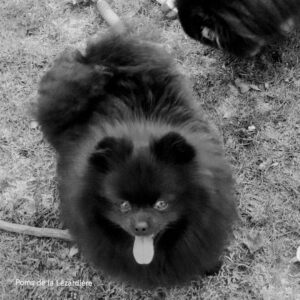I -Heat
-
Pro-oestrus
-
Oestrus
-
Dioestrus
-
Anoestrus
Heat in the bitch

Heat occurs twice a year: most often in spring and autumn.
Female heat corresponds to two stages: pro-oestrus, which marks the beginning of heat, and oestrus, which includes ovulation and the possibility of being mated.
1.Pro-œstrus
This is the first stage of the heat cycle. It can last from 3 to 17 days (9 days on average). The first sign of this stage is the swelling of the vulva. This is one of the best ways to identify the start of a heat cycle. During the proestrus phase, you will notice the following symptoms:
Change of personality:
The changes can be quite small or more significant. A bitch can become more affectionate and clingy with her owner, or she can be a bit grumpy.
Changes in appetite:
It is not uncommon for a bitch to sulk a little during this first week, or on the contrary, to be even hungrier. Whatever the change, it is important to take note of it as it may signal the start of the heat cycle.
Swelling of the vulva:
The amount of swelling in the vulva varies from bitch to bitch. Some bitches swell just a little, while others swell a lot. Bleeding also varies, but is usually light for the first few days and becomes a little heavier in the middle of the week.
Tail folding:
This is a reaction to protect the vulva, either by tucking the tail between the legs or by sitting down whenever another dog approaches.
2.Oestrus
Oestrus usually lasts from 3 to 21 days (9 days on average). This is when your bitch is fertile (her true heat period) and the ovaries begin to release eggs for fertilization. During this phase the bitch will be ready to accept the company of the male. Her tail will no longer be tucked between her legs but to the side, and she will try to be outside more often than usual. It follows its reproductive instinct. During this period, the following symptoms can be observed:
Slight discharge: Previously bright red, the blood discharge now lightens to a little pink.
Softening of the vulva: The initial swelling subsides just enough for the vulva to soften enough to allow penetration.
Flirtatious behaviour: Whereas she used to tuck her tail between her legs to ward off male company, she is now beginning to behave in a flirtatious manner.
3.Diœstrus
As diestrus takes over, the fertile part of the heat cycle ends. This phase can last from 60 to 90 days and at this point the bitch is no longer fertile. If the bitch has been fertilised, the diestrus phase lasts from the end of oestrus until the birth of the puppies (approximately 60 days). The signs of the diestrus phase are:
Gradual disappearance of the swelling of the vulva:
The swelling disappears almost completely within a week but the vulva remains slightly enlarged.
Less flirting:
Whether pregnant or not, the bitch no longer has the conditions for mating and is no longer flirtatious.
4.Anœstrus
Anoestrus is the last phase of the cycle. It is also called the resting period. This is the longest period of the bitch’s sexual cycle, lasting on average 4-5 months, and at the end of this period the heat cycle starts again.
The rutting male

The rutting period in dogs is not cyclical as in many species, but is triggered instantly by contact with the female’s pheromones!
As soon as the dog perceives the pheromones of a bitch in heat, he is immediately in rut: his blood testosterone level increases and directly affects his behaviour. This sex hormone is known for its disinhibiting aspects.
When in rut, your male dog may urinate more often to mark his territory, watch for females and run away to find a bitch in heat, or become agitated.
He will behave in a more assertive, virile, aggressive and dominant manner, with, for example, the risk of fighting with other rutting males in competition…
Dog mating
This infographic illustrates the sexual act or mating between two dogs.
The different stages and duration of the mating are as follows:
- First phase of coitus (about 2 minutes)
- Turning around (about 5 seconds)
- Second phase of coitus (5-45 minutes)
First of all, the male sits on the female (first phase of coitus). If they remain in this position, they risk suffering severe cramps.
For this reason, they change their position (the U-turn).
The dogs continue to mate (second phase of coitus).
The uterus, vagina, bulb, vulva and penis are all involved in the sexual act in dogs.
Two dogs should never be separated during the breeding process. This can have serious consequences such as a vaginal tear or a fracture of the penile bone.
reference : tractive.com
The different stages of mating




